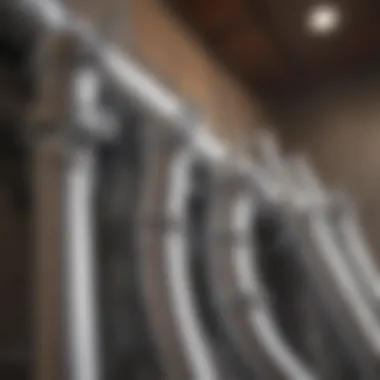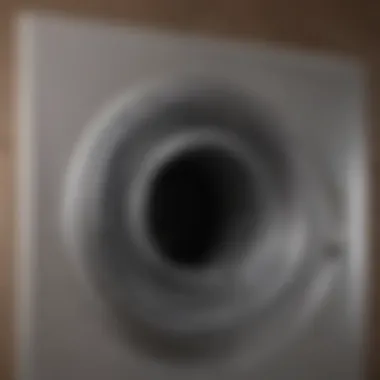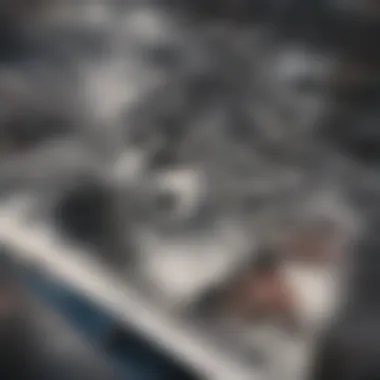Essential Guide to Dryer Vent Pipes at Home Depot


Intro
Understanding dryer vent pipes is essential for maintaining both the efficiency of your laundry appliances and the safety of your home. Many homeowners overlook the significance of proper dryer vent installation and maintenance, which can lead to various issues, including fire hazards and increased energy consumption. Home Depot offers numerous options for dryer vent pipes, making it crucial for consumers to be informed about their choices.
This article serves as a guide for those interested in understanding the intricacies of dryer vent pipes. We will explore the different types available, their installation methods, and provide maintenance tips to ensure optimal performance. Additionally, safety considerations will be outlined to help homeowners and DIY enthusiasts make informed decisions about their dryer vent systems.
Prolusion to Dryer Vent Pipes
Dryer vent pipes play a crucial role in the overall functionality and safety of home appliances. This article provides a detailed look into these essential components, especially focusing on options available at Home Depot. Dryers require proper venting to operate efficiently and safely; otherwise, they can contribute to energy waste and significant safety hazards.
Definition and Purpose
A dryer vent pipe is a conduit that allows hot, moist air and lint from the dryer’s operation to exit the home. It typically connects the dryer to an exterior vent. The primary purpose is to ensure that excess heat and moisture produced during the drying cycle do not build up within the house. Over time, stagnant air can lead to various problems, including mold growth and unpleasant odors.
The vent pipe must meet particular standards to function effectively. It needs to be made of suitable materials that can withstand high temperatures. Additionally, the design should prevent lint accumulation, as blocked vents can lead to dryer inefficiency and increased fire risk.
Importance in Home Safety
The safety aspect associated with dryer vent pipes cannot be overstated. According to the National Fire Protection Association (NFPA), clothes dryers are responsible for a significant number of residential fires each year. Therefore, having a proper dryer vent pipe is not merely about convenience; it is about protecting life and property.
- Fire Hazards: Lint is highly flammable. When dryer ducts become congested, the heat from the dryer can ignite lint, resulting in a fire.
- Carbon Monoxide Poisoning: In systems that utilize natural gas or propane clothes dryers, an improper venting setup can lead to the build-up of carbon monoxide, posing serious health risks.
- Energy Efficiency: An adequately installed dryer vent pipe optimizes the appliance's performance, consequently reducing energy expenses over time.
Properly maintaining and regularly cleaning your dryer vent is essential for safety and efficiency.
Types of Dryer Vent Pipes
Selecting the appropriate dryer vent pipe is essential for ensuring efficient operation and safety of your dryer. The type of vent pipe directly impacts airflow, which in turn affects drying time and energy usage. Furthermore, the right choice can prevent hazards associated with blocked or poorly ventilated systems. In this section, we will explore the three common types of dryer vent pipes available to homeowners.
Rigid Metal Vent Pipes
Rigid metal vent pipes are a popular choice among homeowners for several reasons. They are sturdy and provide a more permanent solution for dryer venting. Made typically from aluminum or galvanized steel, these pipes have a smooth interior that facilitates optimal airflow. This smoothness helps minimize the accumulation of lint, which is a significant fire hazard. Because they are not flexible, they are less prone to kinks or bends that can restrict airflow.
When installing rigid metal vent pipes, it is important to observe local building codes. These codes often require vent pipes to have a specific diameter to ensure proper ventilation. Additionally, avoiding long duct runs is crucial, as longer runs can lead to reduced dryer efficiency. Regular inspection and cleaning of these pipes can further enhance their safety and performance.
Flexible Metal Vent Pipes
Flexible metal vent pipes are another viable option for homeowners. They are made from thin metal and can be easily manipulated to fit various layouts and designs in your laundry area. Their adaptability makes them ideal when dealing with tight spaces or unusual configurations. However, it is essential to choose high-quality flexible pipes, as lower-quality options may deteriorate quickly and pose risks of fire.
Despite their flexibility, these vent pipes can accumulate lint more than rigid counterparts. Homeowners must ensure regular cleaning to prevent blockages. Additionally, flexibility can sometimes lead to kinks during installation, so careful installation practices should be followed to avoid airflow restrictions.
Plastic Vent Pipes
Plastic vent pipes are often considered less ideal than metal options. While they are affordable and lightweight, they present several drawbacks. Plastic vent pipes are not as durable as metal alternatives and can warp or melt under high temperatures, presenting potential hazards for your home. Furthermore, they can accumulate lint in their uneven interior surfaces, leading to blockage and decreased efficiency.
In some regions, local building codes may restrict or even prohibit the use of plastic vent pipes due to fire safety concerns. Therefore, before opting for plastic, homeowners should consult their local regulations. It’s crucial to weigh the cost-saving benefits against the risks associated with selecting a material that lacks longevity and safety.
Regularly maintaining all types of dryer vent pipes is critical for ensuring safe operation. Clear away lint and debris to help prevent fire hazards and improve energy efficiency.
By understanding the different types of dryer vent pipes—rigid metal, flexible metal, and plastic—homeowners can make informed decisions. Each type has its unique characteristics, benefits, and drawbacks. It’s important to consider factors such as installation space, local building codes, and maintenance requirements before making a choice.
Selecting the Right Dryer Vent Pipe


Choosing the appropriate dryer vent pipe is crucial for the effectiveness and safety of your dryer system. The right selection enables proper airflow, reduces fire risks, and ensures that your dryer operates efficiently. Each component plays a significant role, affecting performance and maintenance needs. Homeowners need to consider three primary aspects: the material types, sizing, and local codes.
Material Considerations
When selecting a dryer vent pipe, the material can significantly influence its performance and durability. Common options include aluminum and galvanized steel. Aluminum is lightweight and corrosion-resistant, which makes it ideal for environments with high moisture. On the other hand, galvanized steel offers sturdiness and higher heat resistance, which can be beneficial for dryer installations near heat sources. It is essential to assess your specific needs before making a decision. For instance, if the dryer is situated in a humid area, aluminum might be preferable due to its resistance to rust.
Key Material Options:
- Aluminum: Lightweight, good corrosion resistance.
- Galvanized Steel: Robust, higher heat tolerance but may rust over time if not properly maintained.
- Flexible Metal: Offers convenience during installation but should be used with caution due to potential lint accumulation.
Length and Diameter Requirements
The dimensions of the vent pipe dictate its efficiency. Longer pipes result in increased resistance to airflow, which can hinder performance. Ideally, the length should be minimized, and it's crucial to use a diameter that matches your dryer’s vent outlet. Most dryer vents have a standard diameter of 4 inches. However, if the pipe is too small, it may lead to overheating or improper ventilation. Homeowners should measure the distance from the dryer to the exterior vent and calculate the appropriate size necessary to maintain adequate airflow.
Local Building Codes and Regulations
Compliance with local building codes is fundamental for ensuring safety and legality. Many regions have specific guidelines that dictate the acceptable materials and configurations for dryer vent systems. Before purchasing your piping, it’s wise to visit your city or county website or consult a local authority for any regulations. This may include restrictions on materials, required vent sizes, and safety clearances, all of which need to be followed to avoid fines or unsafe installations.
In summary, selecting the right dryer vent pipe involves understanding material properties, sizing correctly, and adhering to local regulations. This careful consideration will not only ensure optimal performance but also contribute to the safety of the home. By examining these factors closely, homeowners can make informed decisions that enhance functionality and contribute to a safer living environment.
Installation Process
The installation process of dryer vent pipes is not only crucial for the efficiency of your dryer but also essential for the safety of your home. Correct installation ensures that moisture and lint do not build up in the ventilation system, which can lead to serious fire hazards and reduced appliance performance. This section aims to provide practical guidance on how to properly install dryer vent pipes, emphasizing the right tools and materials, detailed steps, and common pitfalls to avoid.
Essential Tools and Materials
To start the installation of dryer vent pipes, one must gather the necessary tools and materials. Having the right equipment on hand simplifies the process and helps prevent mistakes.
Essential tools:
- Screwdriver: For securing joints and mounting brackets.
- Drill: Useful for drilling holes if needed.
- Tape measure: To ensure proper lengths and dimensions.
- Utility knife: For cutting flexible pipes or other materials as needed.
- Level: To make sure the vent pipes are straight and correctly aligned.
- Safety goggles: Protects eyes from debris during installation.
Materials needed:
- Dryer vent pipes: Either rigid or flexible, depending on your specific requirements.
- Clamps: To secure the vent in place.
- Duct tape: Used for sealing joints.
- Vent hood: A cover for the outside termination of the vent pipe to keep pests out.
Step-by-Step Installation Guide
The following step-by-step guide serves as an outline for a successful dryer vent pipe installation:
- Planning the Route: Begin by determining where the dryer vent will exit the home. The path should be as straight as possible. Avoid sharp bends to reduce airflow restriction.
- Measure and Cut: Using a tape measure, calculate the length of vent pipe needed. Cut the pipe to size with a utility knife or saw, considering some extra length for the connections.
- Attach the Pipe: Connect the end of the vent pipe to the dryer. Use clamps to secure it firmly in place. Make sure the connection is tight to prevent leaks.
- Run the Vent to the Outside: Route the pipe to the outside wall. Secure any sections with mounting brackets as necessary. Ensure the slope of the pipe directs any moisture away from the dryer.
- Seal the Joints: Use duct tape to seal all joints. This prevents air leaks and enhances vent performance.
- Install the Vent Hood: Finally, attach the outside vent hood to the exterior of the home. Secure it well and ensure that it opens freely to allow air to escape.
- Test the Installation: Run the dryer for a short time to check airflow. Feel for escaping air at the vent hood. If airflow is weak, reevaluate your connections and angles.
Common Mistakes to Avoid
During installation, there can be several common mistakes that can negatively impact the performance of the dryer and create safety hazards. Awareness of these pitfalls can save time and effort:
- Improper Sealing: Failing to seal joints properly can lead to air leaks, allowing lint and moisture to build up, creating fire hazards. Always use duct tape or clamps to secure connections tightly.
- Ignoring Building Codes: Not adhering to local regulations can result in unsafe installations. Always consult local building codes to ensure compliance.
- Excessive Bends: Using too many bends in the ducting can restrict airflow. Aim for a straight path whenever possible.
- Using Wrong Materials: Avoid using plastic or vinyl vent pipes, as they are less durable and more prone to fire hazards. Stick to rigid or flexible metal pipes for safety.
- Neglecting Maintenance: Even after installation, failure to maintain the vent system can lead to blockages and performance issues over time. Regularly inspect and clean your vents.
Proper installation not only improves efficiency but also enhances safety. Take the time to do it right to protect your home.
By addressing these factors, you can ensure a functional and safe dryer vent system, contributing to better home performance.
Maintaining Dryer Vent Pipes


The maintenance of dryer vent pipes is an often overlooked yet critical aspect of home appliance care. Over time, dirt, lint, and other debris can accumulate within the vent, leading to reduced efficiency and potential hazards. Regular maintenance ensures that your dryer operates safely and effectively, reducing the risk of fire and enhancing its longevity.
Routine Cleaning Practices
Routine cleaning is essential for maintaining dryer vent pipes. Homeowners should make it a habit to clean out the lint trap before every load. This simple step minimizes the amount of lint that enters the vent system. Additionally, a thorough cleaning of the vent pipe itself should be performed at least once a year.
Using a vacuum with a long attachment helps in removing lint that builds up inside the vent. You can also consider investing in a specialized dryer vent cleaning brush that can reach deeper into the pipe. Both methods effectively reduce the risk of clogs and enhance airflow.
Signs of Blockage or Damage
Being aware of the signs indicating potential blockage or damage is crucial. Here are some key indicators:
- Long Drying Times: If clothes take longer than usual to dry, this may suggest inadequate airflow.
- Scent of Lint or Burning: Any unusual smell, especially that of burning lint, should raise immediate concern.
- Visible Lint or Debris: If you see lint around the outside vent or inside the dryer, it’s time for a clean.
- Hot Dryer Exterior: An excessively hot dryer unit may indicate that venting is severely restricted.
Identifying these signs early helps in addressing issues before they escalate, ensuring that the dryer functions optimally.
Professional Maintenance Services
For those who prefer not to handle cleaning and maintenance on their own, professional services are a good option. Many appliance repair companies offer dryer vent cleaning and inspections as part of their services. They have the tools and expertise to thoroughly assess the condition of the vent pipes, identify problems, and resolve them effectively.
Using professional services can save time and prevent safety risks associated with improper maintenance. Homeowners should schedule professional cleaning every few years, especially if they notice any of the aforementioned signs of blockage or if the dryer is aging.
In summary, regular maintenance of dryer vent pipes is essential for optimal performance and safety. Neglecting this aspect can lead to serious hazards, while a proactive approach ensures longevity of the appliances.
By keeping a close eye on routine cleaning, recognizing the signs of blockage, and utilizing professional help when needed, homeowners can maintain their dryer vent pipes efficiently.
Safety Considerations
Understanding safety considerations when working with dryer vent pipes is crucial. Improper installation or maintenance can lead to severe hazards within the home. Not only does it affect the efficiency of your dryer, but it can also pose threats to the safety of the household. Homeowners need to be aware of potential fire hazards and necessary ventilation practices to ensure a safe environment.
Fire Hazards Associated with Poor Venting
One of the most critical hazards linked to dryer venting is the risk of fire. Lint accumulation is the primary cause of fires in dryers. Over time, lint can build up in the vent pipes, restricting airflow. When air cannot escape properly, the dryer overheats, creating a dangerous situation.
Moreover, using improper materials or poorly designed vent systems can exacerbate this issue. Flexible plastic vents are common culprits, as they are more flammable compared to metal alternatives. According to reports, more than 15,000 fires annually are associated with the operation of clothes dryers. Therefore, ensuring a clean and functional vent system is not just advisable but is a vital safety measure.
"Regular cleaning and maintenance of dryer vent systems can significantly reduce fire hazards. This simple act of precaution can save homes and lives."
Proper Ventilation Practices
Proper ventilation is essential for the efficient operation of dryers and the safety of a household. First, always ensure your dryer vent is made of the correct materials. Rigid metal vent pipes, as suggested by experts, should be the standard choice for their durability and safety. Flexible metal ducts can be used, but they must be installed correctly to avoid pitfalls.
Next, it is important to regularly check and clean the vents. This practice ensures airflow is unobstructed, which minimizes the risk of overheating. Pay attention to the following:
- Regular Inspections: Check vent systems at least bi-annually.
- Lint Traps: Always clean these before or after each use.
- Distance and Angles: Keep vent runs as short as possible with minimal bends to prevent lint trapping.
Lastly, ensure that the dryer is properly vented to the exterior of the home. This not only helps with performance but also prevents moisture and heat accumulation inside, which can lead to mold growth and potential structural damage.
By adhering to these proper ventilation practices, homeowners can significantly enhance safety and efficiency within their laundry areas.
Environmental Impact of Dryer Vent Pipes
The topic of the environmental impact of dryer vent pipes is increasingly relevant as homeowners become more aware of their ecological footprints. The materials used in dryer vent pipes and their overall efficiency can significantly influence energy consumption and, by extension, environmental sustainability. Evaluating these factors allows homeowners not only to make informed choices but also to contribute positively to environmental health.


Energy Efficiency Considerations
Energy efficiency is a crucial aspect of dryer vent pipe choice. Rigid metal vent pipes, for example, typically offer superior airflow compared to their flexible counterparts. This enhanced airflow means that dryers can operate more efficiently, reducing energy consumption over time. Paying attention to the length and diameter of the vent pipe is essential. A shorter, more direct path for hot air improves dryer performance and minimizes energy use.
- Key insights on energy efficiency:
- Rigid metal pipes are preferable for their airflow efficiency.
- Shorter vent lengths reduce energy consumption.
- Wider diameter pipes facilitate faster air movement.
When selecting a dryer vent pipe, consider how the design affects drying cycles. An efficient vent can save homeowners money on utility bills while lessening their environmental impact.
Sustainability in Material Choices
The choice of materials also contributes to the sustainability of dryer vent pipes. Materials like aluminum or galvanized steel are widely used because they are both durable and recyclable.
Choosing products that minimize plastic use limits the environmental burden associated with non-biodegradable materials. Furthermore, opting for products made from recycled matter enhances the sustainability profile of the installation. This choice not only alleviates the demand for new raw materials but also supports circular economy principles.
- Consideration points for sustainable materials:
- Rigid metal pipes tend to have a longer lifespan.
- Recyclability of materials is important.
- Products made from recycled materials are preferable.
Ultimately, recognizing the environmental impact of dryer vent pipes guides homeowners towards smarter purchasing decisions. By prioritizing energy efficiency and sustainable materials, one can reduce both costs and ecological footprints.
Cost and Pricing Factors
Understanding the cost and pricing factors for dryer vent pipes is crucial for homeowners and DIY enthusiasts. These considerations not only impact the initial outlay but also determine long-term efficiency and safety. Selecting appropriate materials and budgeting for installation will save trouble later and enhance the system's performance.
Material Costs and Considerations
When selecting dryer vent pipes, material costs are a significant factor. Common materials include metal and plastic. Rigid metal pipes generally cost more due to their durability and safety benefits. On the other hand, flexible metal and plastic pipes tend to be less expensive, but they may incur indirect costs over time related to maintenance or performance issues.
Components with greater resistance to heat and corrosion justify their higher price. Investing in quality materials can result in fewer repairs and less frequent replacements. Therefore, it's wise to balance cost with longevity and effectiveness.
Key cost considerations include:
- Pipe material: Rigid metal pipes are typically more expensive than flexible options or plastics.
- Length of pipe needed: Longer pipes require more material, affecting the total cost.
- Fittings and connectors: These additional parts can add to the overall price but are essential for proper installation.
Installation Expenses
After material selection, installation expenses arise as the next key consideration. Many homeowners choose to take a DIY approach, hoping to cut costs. However, it is paramount to recognize the potential pitfalls involved. Improper installation can lead to airflow issues which might increase energy costs and even create fire hazards. Available installation options include hiring professionals or attempting it themselves. Contractor fees can vary based on region, experience, and specific job requirements. Generally, hiring specialists can ensure the system is set up correctly, leading to better long-term performance.
When calculating installation expenses, keep in mind:
- Labor costs: Professional help can be more costly but often provides peace of mind.
- Tools and equipment needed: A DIY approach may require additional equipment rental or purchase.
- Time investment: Homeowners often underestimate the time needed for proper installation.
Ultimately, understanding both material costs and installation expenses helps in making informed decisions about dryer vent pipes. Investing wisely now can lead to greater savings and safety in the future.
Ending
In this article, we have explored several critical aspects of dryer vent pipes available at Home Depot. Understanding the importance of dryer vent pipes is essential for homeowners. These components not only enhance dryer efficiency but also play a significant role in ensuring safety and reducing energy consumption.
Recap of Key Points
To summarize, here are the important topics covered:
- Types of Dryer Vent Pipes: We discussed rigid metal, flexible metal, and plastic vent pipes. Each type has distinct advantages and disadvantages.
- Selecting the Right Pipe: The decision should consider material, length, diameter, and adherence to local building codes.
- Installation Process: Key tools, a step-by-step guide, and common mistakes were highlighted to aid in effective installation.
- Maintenance: Routine cleaning and recognizing signs of blockage or damage are crucial for long-term performance.
- Safety Aspects: We considered potential fire hazards associated with poor venting and discussed proper ventilation practices.
- Environmental Impact: Assessments on energy efficiency and sustainable material choices were emphasized.
- Cost Factors: A breakdown of material costs and installation expenses was provided to give a clearer financial picture.
Final Recommendations for Homeowners
Homeowners should prioritize selecting the correct vent pipe type based on specific needs. Investing in high-quality materials will pay off in terms of durability and safety. Regular maintenance cannot be overstated; it ensures that the dryer runs effectively while minimizing risks.
Consider enlisting professional help for installation if unsure, particularly in adhering to local codes. Staying informed about energy-efficient practices is also beneficial, helping to lower utility bills in the long run.
Understanding these elements will empower homeowners to make informed decisions, ultimately leading to safer and more efficient drying experiences.















